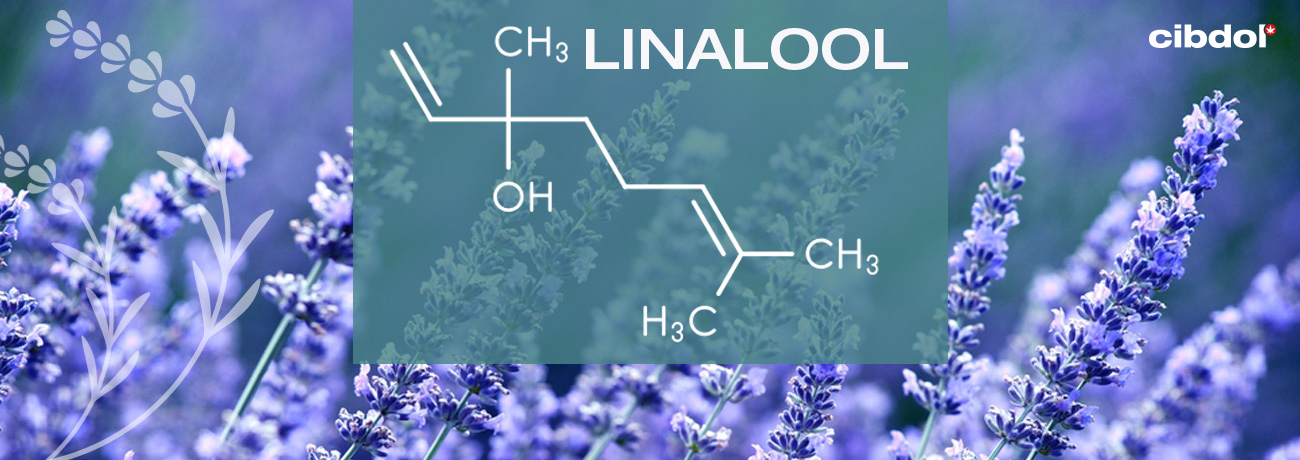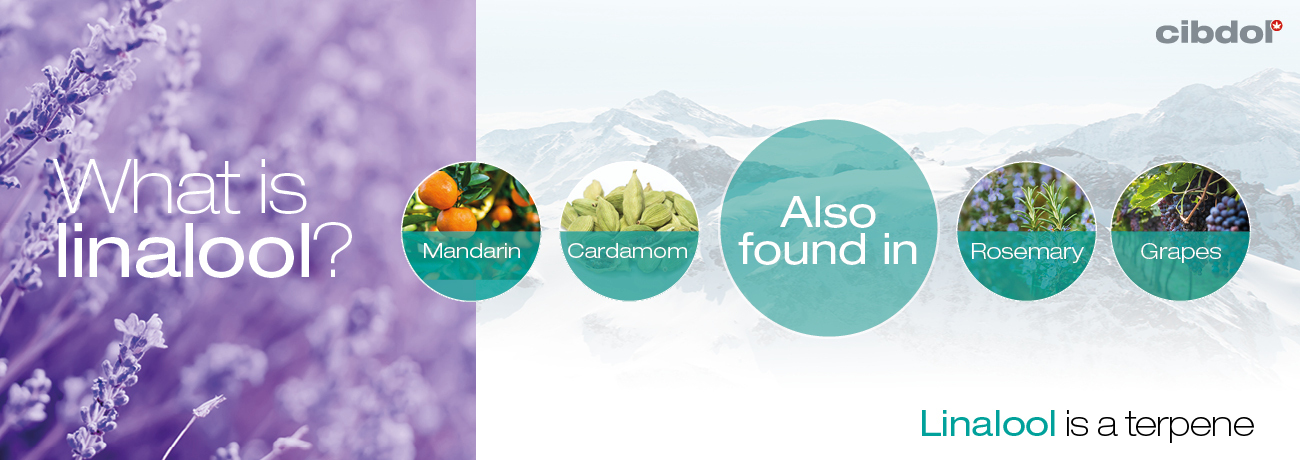What is Linalool?

As one of over 200 terpenes synthesised in cannabis flowers, linalool comprises approximately 6%[1] of the plant’s essential oil.
Contents:
Known more precisely as a monoterpene—due to the two isoprene units in the molecule—linalool plays a contributing role in the recognisable scent of cannabis. However, the terpene underpins the fresh and citrusy aromas of many other plants, herbs, and fruits, too.
Researchers have probed linalool for potential therapeutic effects over the years. Studies have mostly been conducted in cell and animal models, but early results still appear promising.
Continue reading to learn everything you need to know about linalool.
Aroma
Do you appreciate the zesty, slightly stinging scent of citrus fruits? You can thank linalool for that.
Fresh and pleasant—these words best summarise the message linalool sends to the olfactory system. Essences of wood, flowers, citrus, and lavender can all be detected when linalool lights up the nose.
Also found in
Linalool occurs in many plant species, contributing its pleasant scent to numerous well-known culinary herbs and fruits.
The terpene exists in high quantities in lavender, rose, basil, cilantro, oregano, grapes, black tea, bay leaves, lemon, nutmeg, mandarin, cardamom, sage, thyme, silver mint, ginger, spearmint, cinnamon, frankincense, rosemary, and birch bark.
Linalool plays the role of a secondary metabolite in all of these species, which means it doesn’t contribute to the growth and development of the organism. Instead, linalool helps to deter certain herbivorous predators and insect pests thanks to its potent aroma.
Linalool also plays an important role in plant pollination and reproduction[2]. The scent of linalool helps to attract pollinating insects such as bees and butterflies. Interestingly, linalool may have evolved alongside the sensory capabilities of butterflies in order to attract this specific group of pollinators.
Possible effects
Scientists continue to probe terpenes and cannabinoids for their therapeutic effects, and they’ve found some promising results in regards to linalool. Human clinical trials are lacking, but in vitro and in vivo studies provide clues as to what future human studies might reveal.
So far, early research suggests that linalool might possess the following effects:
• Anxiolytic
• Antidepressive
• Sedative
• Analgesic
• Anticonvulsant
Linalool might also enhance the therapeutic effects of numerous cannabinoids. Researchers refer to this synergistic action as the “entourage effect”.
For instance, linalool appears to work alongside THC[3] to increase the muscle-relaxing and anti-Alzheimer's potential of the cannabinoid.
Research also suggests that the terpene might boost the potential anticonvulsant effects of cannabinoids CBD, THCV, and CBDV.
Supporting research
• Anxiolytic
An archive of human and animal research suggests that linalool produces an anxiolytic effect. The terpene appears to reduce the fight or flight response and change the firing of serotonin receptors.
Research[4] published in the journal The Mental Health Clinician details the effects of lavender essential oil—of which linalool is a major component. The paper states that lavender essential oil might help to combat anxiety by increasing parasympathetic activity.
The parasympathetic nervous system makes up one of three branches of the autonomic nervous system. Also known as the “rest and digest system”, this branch decreases heart rate, boosts intestinal activity, and relaxes certain muscles when activated.
Lavender essential oil managed to enhance parasympathetic activity in rats, dogs, and humans—a mechanism that could partly underpin linalool’s anxiolytic effects.
Additionally, research[5] published in The International Journal of Neuropsychopharmacology investigated the effects of lavender essential oil on the human brain.
The randomised, blinded, placebo-controlled trial involved 17 healthy volunteers. The subjects were instructed to take a patented lavender essential oil product every day for eight weeks, at a quantity of 160mg per day.
Researchers analysed the subjects' brains using positron emission tomography and magnetic resonance imaging after the eight weeks had passed. They found decreased binding potential at the 5HT1A receptor—a type of serotonin receptor—in two regions of the brain.
Previous neuroimaging studies suggest that excessive firing at this receptor site could be a contributing factor to anxiety. These findings suggest that linalool exerts anxiolytic effects by decreasing serotonin receptor activity.
The very odour of linalool might be enough to reduce anxious activity within the brain, as displayed in a 2018 study[6] conducted in Japan. The study found linalool odour to produce an anxiolytic effect in mice, without compromising motor activity.
Specifically, the researchers found linalool to produce these effects by acting on GABAᴀ receptors, the same site targeted by the benzodiazepine class of anxiolytics. They concluded that their findings would likely lay the foundations for exploring the clinical application of linalool in the treatment of anxiety.
Another study[7] found that inhaled linalool increased social interaction and decreased aggressive behaviour in mice. Researchers noted that the terpene impaired memory, but only at higher doses.
• Antidepressive
A paper[8] published in Life Science states that linalool possesses antidepressant-like activity. The authors also mention how many plants used in folk medicine to treat anxiety and depression contain high levels of linalool.
The researchers conducted a battery of tests designed to induce these psychological states in mice. They found that linalool exerts antidepressant-like effects through the monoaminergic system—a network that includes the dopaminergic and serotonergic systems.
Further research[9] published in 2013 set out to determine the neurobehavioural and potential toxic effects of linalool. They found the terpene to produce an antidepressant-like effect in mice, without causing any damage to DNA in brain tissue or peripheral blood.
• Sedative
A 2009 paper[10] tested the sedating effects of linalool on mice. The rodents were placed into an inhalation chamber—saturated with either 1% or 3% linalool—for one hour.
The atmosphere with 1% linalool increased sleeping time (while under the influence of sleeping medication) and decreased body temperature. The atmosphere with 3% linalool decreased locomotion in the mice, without impacting motor coordination.
• Analgesic
Could linalool be a painkilling medicine of the future? A study[11] in the European Journal of Pharmacology suggests it could be a possibility; it tested the painkilling and anti-inflammatory effects of the terpene in mice.
Linalool produced a significant effect in a model of pain, and a substance that blocks opioid receptors successfully inhibited its effects. This suggests that linalool produces painkilling effects by activating the opioidergic system, the same site targeted by drugs such as morphine.
• Anticonvulsant
Several constituents within the cannabis plant have exhibited anticonvulsant effects. Linalool might reduce seizures by changing glutamate activation expression. As the primary excitatory neurotransmitter in the brain, glutamate plays a large role in triggering seizures.
Research has found linalool to possess anti-glutamate activity. What’s more, even small levels in certain cannabis strains seem to exert anticonvulsant benefits in humans[12].
[1] Russo, E. B., & Marcu, J. (2017b). Cannabis Pharmacology: The Usual Suspects and a Few Promising Leads. Cannabinoid Pharmacology, 67–134. https://doi.org/10.1016/bs.apha.2017.03.004 [Source]
[2] Guy, P., Kamatou, P., & Viljoen, A. M. (2008). Linalool – A Review of a Biologically Active Compound of Commercial Importance. Natural Product Communications. Published. https://journals.sagepub.com/doi/pdf/10.1177/1934578X0800300727 [Source]
[3] Russo, E. B. (2011c). Taming THC: potential cannabis synergy and phytocannabinoid-terpenoid entourage effects. NCBI. Published. https://www.ncbi.nlm.nih.gov/pmc/articles/PMC3165946/ [Source]
[4] Malcolm, B. J., & Tallian, K. (2017). Essential oil of lavender in anxiety disorders: Ready for prime time? NCBI. https://www.ncbi.nlm.nih.gov/pmc/articles/PMC6007527/ [Source]
[5] Baldinger, P., Hoflich, A. S., Mitterhauser, M., Hahn, A., Rami-Mark, C., Spies, M., Wadsak, W., Lanzenberger, R., & Kasper, S. (2014). Effects of Silexan on the Serotonin-1A Receptor and Microstructure of the Human Brain: A Randomized, Placebo-Controlled, Double-Blind, Cross-Over Study with Molecular and Structural Neuroimaging. International Journal of Neuropsychopharmacology, 18(4), pyu063. https://doi.org/10.1093/ijnp/pyu063 [Source]
[6] Harada, H., Kashiwadani, H., Kanmura, Y., & Kuwaki, T. (2018). Linalool Odor-Induced Anxiolytic Effects in Mice. Frontiers in Behavioral Neuroscience, 12. https://doi.org/10.3389/fnbeh.2018.00241 [Source]
[7] Linck, V., da Silva, A., Figueiró, M., Caramão, E., Moreno, P., & Elisabetsky, E. (2010). Effects of inhaled Linalool in anxiety, social interaction and aggressive behavior in mice. Phytomedicine, 17(8–9), 679–683. https://doi.org/10.1016/j.phymed.2009.10.002 [Source]
[8] Guzmán-Gutiérrez, S. L., Bonilla-Jaime, H., Gómez-Cansino, R., & Reyes-Chilpa, R. (2015). Linalool and β-pinene exert their antidepressant-like activity through the monoaminergic pathway. Life Sciences, 128, 24–29. https://doi.org/10.1016/j.lfs.2015.02.021 [Source]
[9] Coelho, V., Mazzardo-Martins, L., Martins, D. F., Santos, A. R. S., da Silva Brum, L. F., Picada, J. N., & Pereira, P. (2013). Neurobehavioral and genotoxic evaluation of (−)-linalool in mice. Journal of Natural Medicines, 67(4), 876–880. https://doi.org/10.1007/s11418-013-0751-6 [Source]
[10] Linck, V. D. M., da Silva, A. L., Figueiró, M., Luis Piato, N., Paula Herrmann, A., Dupont Birck, F., Bastos Caramão, E., Sávio Nunes, D., Moreno, P. R. H., & Elisabetsky, E. (2009). Inhaled linalool-induced sedation in mice. Phytomedicine, 16(4), 303–307. https://doi.org/10.1016/j.phymed.2008.08.001 [Source]
[11] Peana, A. T., D’Aquila, P. S., Chessa, M., Moretti, M. D., Serra, G., & Pippia, P. (2003). (−)-Linalool produces antinociception in two experimental models of pain. European Journal of Pharmacology, 460(1), 37–41. https://doi.org/10.1016/s0014-2999(02)02856-x [Source]
[12] Russo, E. B., & Marcu, J. (2017c). Cannabis Pharmacology: The Usual Suspects and a Few Promising Leads. Cannabinoid Pharmacology, 67–134. https://doi.org/10.1016/bs.apha.2017.03.004 [Source]
[1] Russo, E. B., & Marcu, J. (2017b). Cannabis Pharmacology: The Usual Suspects and a Few Promising Leads. Cannabinoid Pharmacology, 67–134. https://doi.org/10.1016/bs.apha.2017.03.004 [Source]
[2] Guy, P., Kamatou, P., & Viljoen, A. M. (2008). Linalool – A Review of a Biologically Active Compound of Commercial Importance. Natural Product Communications. Published. https://journals.sagepub.com/doi/pdf/10.1177/1934578X0800300727 [Source]
[3] Russo, E. B. (2011c). Taming THC: potential cannabis synergy and phytocannabinoid-terpenoid entourage effects. NCBI. Published. https://www.ncbi.nlm.nih.gov/pmc/articles/PMC3165946/ [Source]
[4] Malcolm, B. J., & Tallian, K. (2017). Essential oil of lavender in anxiety disorders: Ready for prime time? NCBI. https://www.ncbi.nlm.nih.gov/pmc/articles/PMC6007527/ [Source]
[5] Baldinger, P., Hoflich, A. S., Mitterhauser, M., Hahn, A., Rami-Mark, C., Spies, M., Wadsak, W., Lanzenberger, R., & Kasper, S. (2014). Effects of Silexan on the Serotonin-1A Receptor and Microstructure of the Human Brain: A Randomized, Placebo-Controlled, Double-Blind, Cross-Over Study with Molecular and Structural Neuroimaging. International Journal of Neuropsychopharmacology, 18(4), pyu063. https://doi.org/10.1093/ijnp/pyu063 [Source]
[6] Harada, H., Kashiwadani, H., Kanmura, Y., & Kuwaki, T. (2018). Linalool Odor-Induced Anxiolytic Effects in Mice. Frontiers in Behavioral Neuroscience, 12. https://doi.org/10.3389/fnbeh.2018.00241 [Source]
[7] Linck, V., da Silva, A., Figueiró, M., Caramão, E., Moreno, P., & Elisabetsky, E. (2010). Effects of inhaled Linalool in anxiety, social interaction and aggressive behavior in mice. Phytomedicine, 17(8–9), 679–683. https://doi.org/10.1016/j.phymed.2009.10.002 [Source]
[8] Guzmán-Gutiérrez, S. L., Bonilla-Jaime, H., Gómez-Cansino, R., & Reyes-Chilpa, R. (2015). Linalool and β-pinene exert their antidepressant-like activity through the monoaminergic pathway. Life Sciences, 128, 24–29. https://doi.org/10.1016/j.lfs.2015.02.021 [Source]
[9] Coelho, V., Mazzardo-Martins, L., Martins, D. F., Santos, A. R. S., da Silva Brum, L. F., Picada, J. N., & Pereira, P. (2013). Neurobehavioral and genotoxic evaluation of (−)-linalool in mice. Journal of Natural Medicines, 67(4), 876–880. https://doi.org/10.1007/s11418-013-0751-6 [Source]
[10] Linck, V. D. M., da Silva, A. L., Figueiró, M., Luis Piato, N., Paula Herrmann, A., Dupont Birck, F., Bastos Caramão, E., Sávio Nunes, D., Moreno, P. R. H., & Elisabetsky, E. (2009). Inhaled linalool-induced sedation in mice. Phytomedicine, 16(4), 303–307. https://doi.org/10.1016/j.phymed.2008.08.001 [Source]
[11] Peana, A. T., D’Aquila, P. S., Chessa, M., Moretti, M. D., Serra, G., & Pippia, P. (2003). (−)-Linalool produces antinociception in two experimental models of pain. European Journal of Pharmacology, 460(1), 37–41. https://doi.org/10.1016/s0014-2999(02)02856-x [Source]
[12] Russo, E. B., & Marcu, J. (2017c). Cannabis Pharmacology: The Usual Suspects and a Few Promising Leads. Cannabinoid Pharmacology, 67–134. https://doi.org/10.1016/bs.apha.2017.03.004 [Source]












